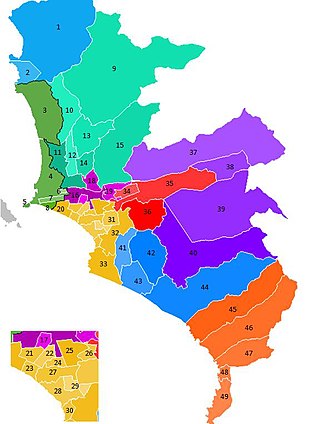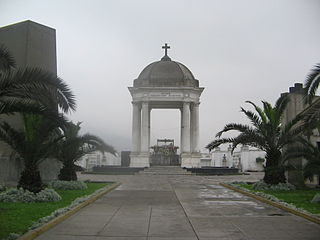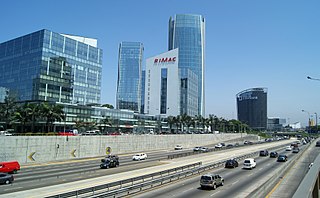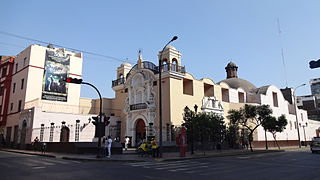
The National University of San Marcos is a public research university located in Lima, the capital of Peru. It is considered the most important, recognized and representative educational institution at the national level. At the continental level, it is the first officially established and the oldest continuously operating university in the Americas, which is why it appears in official documents and publications as "University of Peru, Dean University of the Americas".

The Lima Metropolitan Area is an area formed by the conurbation of the Peruvian provinces of Lima and Callao. It is the largest of the metropolitan areas of Peru, the seventh largest in the Americas, the fourth largest in Latin America, and among the thirty largest in the world. The conurbation process started to be evident in the 1980s.
Peruvian art has its origin in the Andean civilizations. These civilizations rose in the territory of modern Peru before the arrival of the Spanish.

Presbyter Matías Maestro Cemetery, formerly the General Cemetery of Lima, is a cemetery, museum and historical monument located in the Barrios Altos neighbourhood of Lima District, in Lima, Peru. Inaugurated on May 31, 1808, it was the first pantheon in the city since burials were previously held in the city's churches. It was named in honour of its designer, Spanish priest Matías Maestro.

The Campo de Marte, also known as the Plaza de la Revolución, is a public park in Jesús María District, Lima, Peru. It is one of the largest parks in the metropolitan area of the city, and similar in size to the Park of the Exhibition and the Park of the Reserve. It was originally part of the Santa Beatriz area of Lima District and, from 1903 to 1938, housed the Santa Beatriz Hippodrome until its replacement by the one in San Felipe estate, located further south in the district.

The Plaza San Martín is one of the most representative public spaces of the city of Lima, Peru. It is located at the ninth block of Colmena avenue, within the Historic Centre of Lima which was declared a World Heritage Site in 1988 by UNESCO. It is located near the Plaza Mayor of Lima and is connected to it by the Jiron de la Union. Its central monument gives homage to Peru's liberator, José de San Martín.
Jorge Piqueras was a visual artist born in Peru and with Peruvian and Spanish nationality. Jorge Piqueras is recognized as one of the most important Peruvian artists of the twentieth century. Among contemporary Latin American artists, he stands out as a pioneer in geometric painting, as well as for his distinctive sculptural production. Piqueras’ work covers a wide range of materials and media, including sculpture, painting, collage, photography and assemblage.
The following is a timeline of the history of the city of Lima, Peru.

Mario Testino Museum is a non-profit organization founded by Peruvian fashion photographer Mario Testino, in 2012. It's a platform for the development of creative industries, a window for the international contemporary art in Lima and for peruvian talent to the world. MATE presents exhibitions from contemporary artists next to the permanent exhibition of Mario Testino's work.

The National Museum of Peru is a national museum in Lurín District, Lima, Peru, located within the archaeological zone of Pachacamac. The museum will hold over a half million artifacts of the Pre-Columbian era and Inca Empire, ranging back to 5,000 BCE. It opened in July 2021 as part of Peru's bicentennial celebrations and is capable of accepting 15,000 guests per day.

The Palacio de la Magdalena is a viceregal house located in the district of Pueblo Libre in Lima. It is located near the Plaza de los Libertadores, and is also known as the Quinta de los Libertadores. The building was declared a national monument in 1972.

Luis Fernán Bedoya Reyes Expressway, also known by its former name, Paseo de la República, or by its nickname, El Zanjón, is the most representative avenue of Lima, Peru. It crosses the districts of Lima, Lince, La Victoria, San Isidro, Surquillo, Miraflores, Barranco and Chorrillos from north to south along 66 blocks. COSAC I of the Metropolitano extends along its entire length, being one of the widest avenues in the city and country.

The Lima Tramway was a mass transportation system that serviced the city of Lima, as well as then neighbouring Callao, Magdalena del Mar, Miraflores, Barranco and Chorrillos, inaugurated in 1878 and closed in 1965.

Huaura is a city in Peru. It is the capital of the homonymous district located in the province of Huaura in the department of Lima. It had an estimated population of 24,668 according to the 2017 census. It ceased to be the provincial capital in 1866 in favor of the city of Huacho and is part of the conurbation formed around the latter by means of two bridges over the Huaura River.

The Monumental Museum of the District Municipality of Huanta, also known simply as the Huaura Balcony, is a war museum located in the Peruvian city of Huaura, dedicated to the memory of José de San Martín and the Liberating Expedition of Peru. The museum is housed in a Viceregal house that originally belonged to the Royal Customs of Lima. It was declared a historical monument by Law No. 9636 of October 28, 1942.

The Church of Jesus, Mary, and Joseph is a Catholic church and monastery located in the corner of Moquegua and Camaná streets. It was built in a baroque and Rococo style in 1678.

José Carlos Mariátegui Museum is a historic house museum located on the final residence of Peruvian writer José Carlos Mariátegui, where he spent the last five years of his life. The museum is dedicated to the life and work of Mariátegui, as well as that of his wife Anna and partner Victoria Ferrer, in the context of how the rooms in the household were used. Mariátegui moved into the house in 1925.

The National Museum of Peruvian Culture, formerly the National Archaeology Museum, is a museum dedicated to Peruvian culture in Lima, Peru.

Rospigliosi Castle is a castle and museum in the neighbourhood of Santa Beatriz in Lima District, Lima, Peru. Since 1959, part of the castle is occupied by the Aeronautical Museum of Peru, previously housed at Las Palmas Air Base.

















